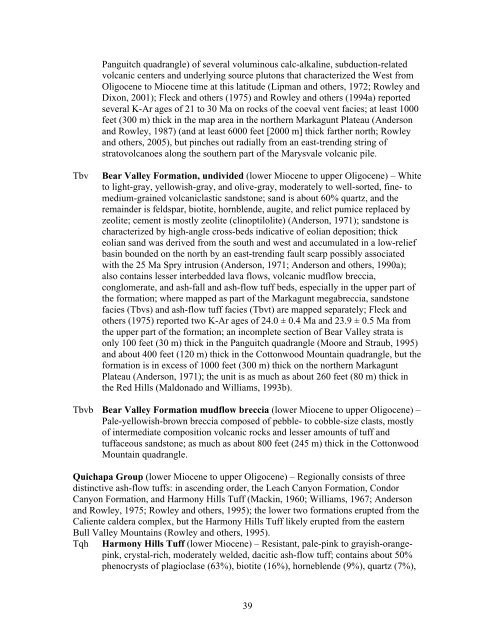Interim Geologic Map of the West Part of - Utah Geological Survey
Interim Geologic Map of the West Part of - Utah Geological Survey
Interim Geologic Map of the West Part of - Utah Geological Survey
You also want an ePaper? Increase the reach of your titles
YUMPU automatically turns print PDFs into web optimized ePapers that Google loves.
Panguitch quadrangle) <strong>of</strong> several voluminous calc-alkaline, subduction-relatedvolcanic centers and underlying source plutons that characterized <strong>the</strong> <strong>West</strong> fromOligocene to Miocene time at this latitude (Lipman and o<strong>the</strong>rs, 1972; Rowley andDixon, 2001); Fleck and o<strong>the</strong>rs (1975) and Rowley and o<strong>the</strong>rs (1994a) reportedseveral K-Ar ages <strong>of</strong> 21 to 30 Ma on rocks <strong>of</strong> <strong>the</strong> coeval vent facies; at least 1000feet (300 m) thick in <strong>the</strong> map area in <strong>the</strong> nor<strong>the</strong>rn Markagunt Plateau (Andersonand Rowley, 1987) (and at least 6000 feet [2000 m] thick far<strong>the</strong>r north; Rowleyand o<strong>the</strong>rs, 2005), but pinches out radially from an east-trending string <strong>of</strong>stratovolcanoes along <strong>the</strong> sou<strong>the</strong>rn part <strong>of</strong> <strong>the</strong> Marysvale volcanic pile.TbvBear Valley Formation, undivided (lower Miocene to upper Oligocene) – Whiteto light-gray, yellowish-gray, and olive-gray, moderately to well-sorted, fine- tomedium-grained volcaniclastic sandstone; sand is about 60% quartz, and <strong>the</strong>remainder is feldspar, biotite, hornblende, augite, and relict pumice replaced byzeolite; cement is mostly zeolite (clinoptilolite) (Anderson, 1971); sandstone ischaracterized by high-angle cross-beds indicative <strong>of</strong> eolian deposition; thickeolian sand was derived from <strong>the</strong> south and west and accumulated in a low-reliefbasin bounded on <strong>the</strong> north by an east-trending fault scarp possibly associatedwith <strong>the</strong> 25 Ma Spry intrusion (Anderson, 1971; Anderson and o<strong>the</strong>rs, 1990a);also contains lesser interbedded lava flows, volcanic mudflow breccia,conglomerate, and ash-fall and ash-flow tuff beds, especially in <strong>the</strong> upper part <strong>of</strong><strong>the</strong> formation; where mapped as part <strong>of</strong> <strong>the</strong> Markagunt megabreccia, sandstonefacies (Tbvs) and ash-flow tuff facies (Tbvt) are mapped separately; Fleck ando<strong>the</strong>rs (1975) reported two K-Ar ages <strong>of</strong> 24.0 ± 0.4 Ma and 23.9 ± 0.5 Ma from<strong>the</strong> upper part <strong>of</strong> <strong>the</strong> formation; an incomplete section <strong>of</strong> Bear Valley strata isonly 100 feet (30 m) thick in <strong>the</strong> Panguitch quadrangle (Moore and Straub, 1995)and about 400 feet (120 m) thick in <strong>the</strong> Cottonwood Mountain quadrangle, but <strong>the</strong>formation is in excess <strong>of</strong> 1000 feet (300 m) thick on <strong>the</strong> nor<strong>the</strong>rn MarkaguntPlateau (Anderson, 1971); <strong>the</strong> unit is as much as about 260 feet (80 m) thick in<strong>the</strong> Red Hills (Maldonado and Williams, 1993b).Tbvb Bear Valley Formation mudflow breccia (lower Miocene to upper Oligocene) –Pale-yellowish-brown breccia composed <strong>of</strong> pebble- to cobble-size clasts, mostly<strong>of</strong> intermediate composition volcanic rocks and lesser amounts <strong>of</strong> tuff andtuffaceous sandstone; as much as about 800 feet (245 m) thick in <strong>the</strong> CottonwoodMountain quadrangle.Quichapa Group (lower Miocene to upper Oligocene) – Regionally consists <strong>of</strong> threedistinctive ash-flow tuffs: in ascending order, <strong>the</strong> Leach Canyon Formation, CondorCanyon Formation, and Harmony Hills Tuff (Mackin, 1960; Williams, 1967; Andersonand Rowley, 1975; Rowley and o<strong>the</strong>rs, 1995); <strong>the</strong> lower two formations erupted from <strong>the</strong>Caliente caldera complex, but <strong>the</strong> Harmony Hills Tuff likely erupted from <strong>the</strong> easternBull Valley Mountains (Rowley and o<strong>the</strong>rs, 1995).Tqh Harmony Hills Tuff (lower Miocene) – Resistant, pale-pink to grayish-orangepink,crystal-rich, moderately welded, dacitic ash-flow tuff; contains about 50%phenocrysts <strong>of</strong> plagioclase (63%), biotite (16%), horneblende (9%), quartz (7%),39
















